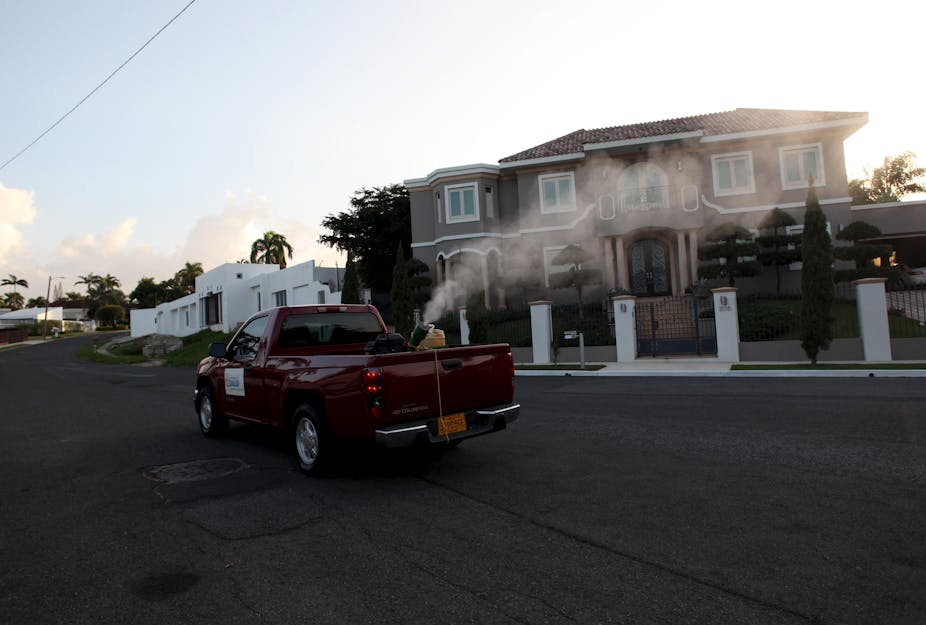The United States declared Zika a public health emergency in Puerto Rico in August 2016.
Over 28,000 cases of Zika were reported in Puerto Rico as of Oct. 26. In contrast, just over 4,000 cases of Zika were reported in the continental U.S. and Hawaii by the same date. Most of these cases are travel-related, meaning that people are infected while abroad. But in Puerto Rico, 98 percent of Zika cases are locally acquired. It is estimated that up 80 percent of people who are infected with Zika are asymptomatic, which means that reported cases may be just a fraction of those who may be infected.
The U.S. Surgeon General said that one in four Puerto Ricans could be infected by the end of the year. A recent study by the Centers for Disease Control and Prevention estimated that 5,900 to 10,300 pregnant women might get infected during the initial Zika outbreak in Puerto Rico. In the absence of effective interventions like birth control or mosquito control, about 100 to 270 infants may be born with Zika-related microcephaly from mid-2016 to mid-2017.
So why is Zika so much worse in Puerto Rico than in the continental U.S.?
Mosquito-borne diseases are complex. Environmental, social, political and cultural factors can influence their transmission. And Puerto Rico, like other parts of the Caribbean and Latin America, has the perfect mix of conditions for a mosquito borne virus to spread widely.

Environmental factors
Since the Zika virus was identified in Brazil, it has spread through most of the countries in the Western Hemisphere, Latin America and the Caribbean, including the continental United States. All these areas have something in common: the Aedes aegypti mosquito.
Ae. aegypti mosquitoes can also transmit Chikungunya and dengue viruses. This species is prevalent in Puerto Rico, where temperature, humidity and rainfall make it a perfect place for mosquitoes to breed all year long.
By contrast, in most of the states in the continental U.S., these environmental conditions are met just at the end of spring and during summer (though this is slowly shifting over time, thanks to climate change).
The only state with confirmed local transmission of Zika virus is Florida, and transmission there is occurring in only two areas in Miami-Dade County. Up to Oct. 26, 2016, 180 local related Zika infections have been confirmed.
But it is expected that with the lower temperatures during winter the risk of Zika will also decrease, because mosquitoes need optimal temperatures to reproduce.
Ae. aegypti breeds close to where people live
Ae. aegypti mosquitoes like to feed on people, and often breed in stagnant water in households or in areas near where people live.
In areas without infrastructure to supply water to the entire population or with inappropriate waste management, people may store water in or near their homes or leave waste containers and tires uncovered. This can create more breeding sites for the mosquito. More mosquitoes means more mosquito bites.
In Puerto Rico, Aedes mosquito-breeding sites are mainly used and discarded car tires, which the government is trying to collect to reduce mosquito densities and contain the spread of the virus. Pails, pets’ water bowls and water fountains, for example, also contribute to the problem.
Population growth and internal migration, particularly to unplanned urban areas with poor sanitary conditions, can move more people into areas where Ae. aegypti mosquitoes densities are higher. This is characteristic of Latin America and the Caribbean overall.
In Puerto Rico, as in other tropical areas, window and door screens and air conditioning aren’t as common as they are in the continental U.S. These are considered luxuries for most of the medium and low socioeconomic classes. Simple things like window screens, use of repellent or air conditioning make a difference.
As part of Zika prevention efforts, the government of Puerto Rico is installing or repairing window and door screens in low-income households with pregnant women and women of childbearing age within the public housing system.

Political and cultural factors
The most effective way to prevent mosquito-borne diseases is to control mosquito densities. But mosquito control strategies, such as insecticides and elimination of potential breeding sites, are unsustainable and ineffective in complex transmission settings like Puerto Rico and other tropical areas.
For instance, health officials have known these breeding sites are a major factor in the spread of mosquito-borne illnesses in Puerto Rico for a long time. But efforts to eliminate these sites and control the spread of diseases have not been successful due to multiple environmental and social conditions that make the ideal setting for the mosquito to breed and difficult to control.
In contrast, in the U.S. the mosquito densities are low and the population takes action in doing its own pest and mosquito control, reducing the mosquito populations that can lead to an outbreak.
The fact that mosquito-borne infections are so common in Puerto Rico means that perceived risk from Zika is low. Dengue, for instance, is endemic in Puerto Rico. If Zika is not perceived as a high risk, that means many people do not use repellent or wear long sleeves and long pants as additional protection against mosquito bites.
Puerto Rico’s ongoing economic crisis has weakened the island’s health sector, which can lead late detection of outbreaks, delaying control strategies.
However, the Zika funding bill Congress passed on Sept. 28 allocated money to fight the virus, as well as to support Medicaid and local health centers in Puerto Rico. This funding may help control transmission of the virus (mosquito control) and fund preventative efforts, like vaccine development.
It’s possible to reduce mosquito-borne diseases, even in places where the conditions are ideal for mosquitoes like Ae. aegypti to flourish. Getting rid of standing water – even small amount in flower pots or bird paths – eliminates places where female mosquitoes lay their eggs. Installing window screens and mosquito repellent can keep mosquitoes at bay.

